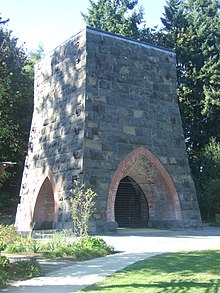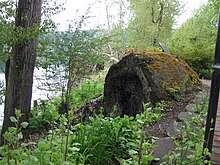
Lake Oswego is a city in the U.S. state of Oregon, primarily in Clackamas County, with small portions extending into neighboring Multnomah and Washington counties. Population in 2020 was 40,731, a 11.2% increase since 2010. Located about 7 miles (11 km) south of Portland and surrounding the 405-acre (164 ha) Oswego Lake, the town was founded in 1847 and incorporated as Oswego in 1910. The city was the hub of Oregon's brief iron industry in the late 19th century, and is today a suburb of Portland.

Wrought iron is an iron alloy with a very low carbon content in contrast to that of cast iron. It is a semi-fused mass of iron with fibrous slag inclusions, which give it a wood-like "grain" that is visible when it is etched, rusted, or bent to failure. Wrought iron is tough, malleable, ductile, corrosion resistant, and easily forge welded, but is more difficult to weld electrically.

A blast furnace is a type of metallurgical furnace used for smelting to produce industrial metals, generally pig iron, but also others such as lead or copper. Blast refers to the combustion air being supplied above atmospheric pressure.

A bloomery is a type of metallurgical furnace once used widely for smelting iron from its oxides. The bloomery was the earliest form of smelter capable of smelting iron. Bloomeries produce a porous mass of iron and slag called a bloom. The mix of slag and iron in the bloom, termed sponge iron, is usually consolidated and further forged into wrought iron. Blast furnaces, which produce pig iron, have largely superseded bloomeries.

The Lehigh Crane Iron Company, later renamed Crane Iron Company, was a major ironmaking firm in the Lehigh Valley from its founding in 1839 until its sale in 1899. It was based in Catasauqua, Pennsylvania, and was founded by Josiah White and Erskine Hazard, who financed its development through their Lehigh Coal & Navigation Company, which promoted the then-novel technique of smelting iron ore with anthracite coal. This was an important cost and energy savings technique, credited with eliminating the need for either expensive charcoal or coke producing processes and transport costs that proved central to the acceleration of the American industrial revolution.

Iron plantations were rural localities emergent in the late-18th century and predominant in the early-19th century that specialized in the production of pig iron and bar iron from crude iron ore. Such plantations derive their name from two sources: first, because they were nearly self-sufficient communities despite an almost singular focus on the production of iron to be sold on the market, and second, because of the large swaths of forest and land necessary to provide charcoal fuel and ore for their operations. The first plantations stretched across the Northeast, Midwest, and Southern United States, “the chief charcoal iron producing states [being] Pennsylvania, Ohio, New York, Virginia, Connecticut, Maryland, Missouri, Tennessee, and Kentucky." Many produced raw materials used in the American Revolution or to be exported to England. Throughout the remainder of the 19th century, however, only locations that adopted new technologies first introduced by competing coal- and coke-powered smelters in the rapidly industrializing field persisted.

Nittany Furnace, known earlier as Valentine Furnace, was a hot blast iron furnace located in Spring Township, Centre County, Pennsylvania, United States. Placed in operation in 1888 on the site of an older furnace, it was an important feature of Bellefonte economic life until it closed in 1911, no longer able to compete with more modern steel producers.
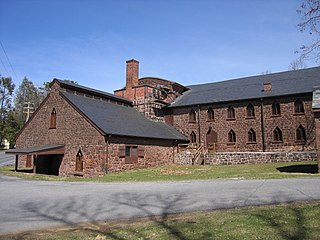
Cornwall Iron Furnace is a designated National Historic Landmark that is administered by the Pennsylvania Historical and Museum Commission in Cornwall, Lebanon County, Pennsylvania in the United States. The furnace was a leading Pennsylvania iron producer from 1742 until it was shut down in 1883. The furnaces, support buildings and surrounding community have been preserved as a historical site and museum, providing a glimpse into Lebanon County's industrial past. The site is the only intact charcoal-burning iron blast furnace in its original plantation in the western hemisphere. Established by Peter Grubb in 1742, Cornwall Furnace was operated during the Revolution by his sons Curtis and Peter Jr. who were major arms providers to George Washington. Robert Coleman acquired Cornwall Furnace after the Revolution and became Pennsylvania's first millionaire. Ownership of the furnace and its surroundings was transferred to the Commonwealth of Pennsylvania in 1932.
Visvesvaraya Iron and Steel Plant (VISL), a unit of Steel Authority of India Limited, is a plant involved in the production of alloy steels and pig iron. It is located in the city of Bhadravathi, India. It was started as the Mysore Iron Works on 18 January 1923 by Nalvadi Krishnaraja Wodeyar and his Diwan Sir M Visvesvaraya. It is now a steel plant under the jurisdiction of the Steel Authority of India Limited.
Charcoal iron is the substance created by the smelting of iron ore with charcoal.
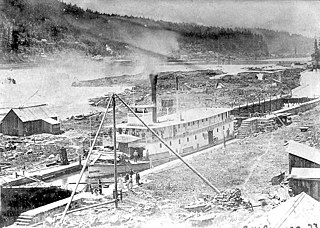
The Willamette River flows northwards down the Willamette Valley until it meets the Columbia River at a point 101 miles from the Pacific Ocean, in the U.S. state of Oregon.

Oswego Lake is a lake in Clackamas County, Oregon that is completely surrounded by the city of Lake Oswego. Though the lake is naturally occurring, it has been significantly altered because of the concrete dam that has increased its size to 431.7 acres (1.747 km2). The United States Geological Survey records the official name as Lake Oswego and, because of its artificially increased size, classifies it as a reservoir. To distinguish it from the city, however, the lake is usually called Oswego Lake.

Bellefonte Furnace was a hot blast iron furnace located in Bellefonte, Pennsylvania. Founded in 1888, it was the first hot blast, coke-fueled iron furnace to be built in Centre County, Pennsylvania. While its founders hoped to transform Centre County's iron industry with modern technology, the furnace struggled to operate at a profit and was out of operation from 1893 until 1899. Thereafter, it operated more or less continuously until 1910, and was demolished four years later. It should not be confused with the charcoal-fueled Bellefonte Furnace and Forge on Logan Branch, which was replaced by Valentine Furnace.

The Oregon Iron Company Furnace, or Oswego Iron Furnace, is an iron furnace used by the Oregon Iron Company, in Lake Oswego, Oregon's George Rogers Park, in the United States. The structure was added to the National Register of Historic Places in 1974 and underwent a major renovation in 2010. The current furnace is the only structure that remains of the original iron company, and is the oldest industrial landmark in the state of Oregon.
The Grubb Family Iron Dynasty was a succession of iron manufacturing enterprises owned and operated by Grubb family members for more than 165 years. Collectively, they were Pennsylvania's leading iron manufacturer between 1840 and 1870.
In 2022, the United States was the world’s third-largest producer of raw steel, and the sixth-largest producer of pig iron. The industry produced 29 million metric tons of pig iron and 88 million tons of steel. Most iron and steel in the United States is now made from iron and steel scrap, rather than iron ore. The United States is also a major importer of iron and steel, as well as iron and steel products.

The US iron and steel industry has paralleled the industry in other countries in technological developments. In the 1800s, the US switched from charcoal to coal in ore smelting, adopted the Bessemer process, and saw the rise of very large integrated steel mills. In the 20th century, the US industry successively adopted the open hearth furnace, then the basic oxygen steelmaking process. Since the American industry peaked in the 1940s and 1950s, the US industry has shifted to small mini-mills and specialty mills, using iron and steel scrap as feedstock, rather than iron ore.
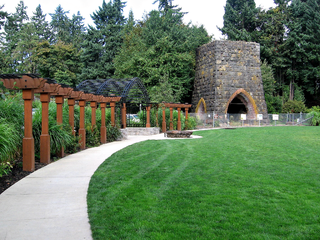
George Rogers Park is a 26-acre (11 ha) public park at intersection of Ladd and South State streets in Lake Oswego, Oregon. This park contains two baseball fields, a soccer field, access to the Willamette River, a memorial garden area, restrooms, a playground, and two outdoor tennis courts. The park also features the Oregon Iron Company Furnace, which was placed on the National Register of Historic Places by the Department of the Interior. The park is named after George Rogers—a City Councilman—in appreciation for his devoted efforts to develop and maintain the grounds.

The British and Tasmanian Charcoal Iron Company (BTCIC) was an iron mining and smelting company that operated from 1874 to 1878 in Northern Tasmania, Australia. It was formed by floating the operations of a private company, the Tasmanian Charcoal Iron Company that operated between 1871 and 1874.
The South Australian Iron and Steel Company, officially South Australian Iron and Steel Company Limited, was a colonial era iron-making venture, located in the Hindmarsh Tiers, near Mount Jagged, in the upper reaches of the Hindmarsh River Valley, South Australia. Its blast furnace operated intermittently, over the period from 16 July to 5 December 1874.
